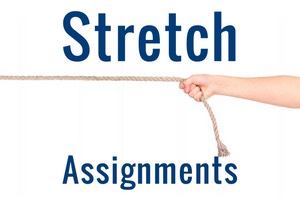Stretch Assignments Can Develop Leadership Skills
Lisa Thompson, LPC, PCC – Managing Director, Professional Services
 As we enter a new year, many companies are taking a hard look at their leadership development programs as they prepare to onboard new executives and develop current ones. If your goal is to develop future leaders within your organization, stretch assignments can be an excellent way to assess their potential. Challenging an executive with a short-term assignment outside his or her comfort zone creates an opportunity to build new skills.
As we enter a new year, many companies are taking a hard look at their leadership development programs as they prepare to onboard new executives and develop current ones. If your goal is to develop future leaders within your organization, stretch assignments can be an excellent way to assess their potential. Challenging an executive with a short-term assignment outside his or her comfort zone creates an opportunity to build new skills.
For example, an executive who tends to listen to others in the C-suite could be encouraged to lead a discussion at a company event, or a corporate presentation at a chamber of commerce meeting. A sales or marketing leader who spends the day with customers and prospects might be given an operational or technical assignment, such as analyzing the supply chain and making recommendations for improvement.
When it’s time to open a new office or launch a new product, rather than giving the assignment to your “go-to” executive, why not use it as a stretch assignment for an up-and-coming leader? And because teambuilding is one of the most important leadership skills, give that responsibility to the project leader as well.
Forward-looking organizations should formalize the stretch assignment process as an integral component of the leadership development program. Here are some of the steps to consider:
- Determine the skill sets needed for C-suite success within the organization. They may be soft skills, such as the ability to speak comfortably in public, build persuasive presentations or assess a subordinate’s managerial potential. Or they could be technical skills, such as assessing legal risks or analyzing financial scenarios.
- Identify skills gaps in your leadership talent pool. This is best done through individual assessments and discussions, as every executive has a unique set of strengths, weaknesses, corporate objectives and personal career goals. Consider engaging an outside professional assessment firm that can use metrics-based assessment and benchmarking instruments, and that can provide expert and unbiased metrics and evaluations.
- Look for stretch assignments that can close those skills gaps. This is where formalizing the process will pay off, because it builds awareness of those short-term experiential learning opportunities and attaches formal objectives and follow-up evaluations.
- Assess the results. Once the assignment is completed, it’s essential to review the project with the leader. Understanding what did and did not go well is important for the executive to learn from the experience, as well as for the manager to know how far the executive can be stretched in the current role or developed for a higher-level role.
A formal stretch assignment process can be easily integrated into an organization’s succession plan. Giving a new project to the number-two person in a department, rather than the top manager, is one example of how stretch assignments can help you evaluate a future leader’s potential. When an executive succeeds in a stretch role, it builds self-confidence, experience and skills that benefit both the individual and the entire organization.














